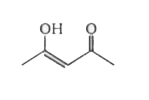Which would be the most stable conformation of trans-1-ethyl-3-methylcyclohexane ?
equatorial (methyl) -equatorial (ethyl)
axial (methyl) -equatorial (ethyl)
axial (methyl)-axial (ethyl)
axial (ethyl)-equatorial (methyl)
The correct Answer is:B
To determine the most stable conformation of trans-1-ethyl-3-methylcyclohexane, we need to analyze the chair conformation of the cyclohexane ring and the positions of the substituents (ethyl and methyl groups).
1. Draw the Chair Conformation of Cyclohexane:
- Cyclohexane predominantly exists in a chair conformation, which minimizes steric strain. Draw the basic chair structure of cyclohexane.
2. Identify the Positions of the Substituents:
- In trans-1-ethyl-3-methylcyclohexane, the ethyl (C2H5) group is at position 1 and the methyl (CH3) group is at position 3. Since they are trans to each other, one group will be in an equatorial position and the other in an axial position.
3. Assign the Substituents:
- To minimize steric hindrance, the larger substituent (ethyl group) should be placed in the equatorial position. Therefore, the ethyl group will be in the equatorial position, and the methyl group will be in the axial position.
4. Analyze Steric Interactions:
- If the ethyl group is in the equatorial position, it avoids 1,3-diaxial interactions with the axial hydrogens on the cyclohexane ring. The axial methyl group will have some steric interactions, but they are less significant compared to placing the ethyl group in an axial position.
5. Conclusion:
- The most stable conformation of trans-1-ethyl-3-methylcyclohexane is the one where the ethyl group is in the equatorial position and the methyl group is in the axial position.
Final Answer:
The most stable conformation of trans-1-ethyl-3-methylcyclohexane has the ethyl group in the equatorial position and the methyl group in the axial position.
---
- Cyclohexane predominantly exists in a chair conformation, which minimizes steric strain. Draw the basic chair structure of cyclohexane.
- In trans-1-ethyl-3-methylcyclohexane, the ethyl (C2H5) group is at position 1 and the methyl (CH3) group is at position 3. Since they are trans to each other, one group will be in an equatorial position and the other in an axial position.
- To minimize steric hindrance, the larger substituent (ethyl group) should be placed in the equatorial position. Therefore, the ethyl group will be in the equatorial position, and the methyl group will be in the axial position.
- If the ethyl group is in the equatorial position, it avoids 1,3-diaxial interactions with the axial hydrogens on the cyclohexane ring. The axial methyl group will have some steric interactions, but they are less significant compared to placing the ethyl group in an axial position.
- The most stable conformation of trans-1-ethyl-3-methylcyclohexane is the one where the ethyl group is in the equatorial position and the methyl group is in the axial position.
The most stable conformation of trans-1-ethyl-3-methylcyclohexane has the ethyl group in the equatorial position and the methyl group in the axial position.
Topper's Solved these Questions
- STEREOISOMERISMBOOK - RESONANCE ENGLISHCHAPTER - STEREOISOMERISMEXERCISE - EXERCISE (PART III : PRACTICE TEST-2 (IIT-JEE (ADVANCED PATTERN))
23 Videos
- STEREOISOMERISMBOOK - RESONANCE ENGLISHCHAPTER - STEREOISOMERISMEXERCISE - EXERCISE (ADDITIONAL PROBLEMS FOR SELF PRACTICE (APSP)) PART 1
30 Videos
- SOLUTIONSBOOK - RESONANCE ENGLISHCHAPTER - SOLUTIONSEXERCISE - Advabced Level Problems (PART-2)
35 Videos
- STRUCTURAL IDENTIFICATIONBOOK - RESONANCE ENGLISHCHAPTER - STRUCTURAL IDENTIFICATIONEXERCISE - Advanced level Problems (Part-III)
12 Videos
Similar Questions
Knowledge Check
The most stable conformation of cyclohexane is
ABoatBHalf-chairCChairDTwist-boatThe most stable conformation of ethylene glycol is :
AAntiBGaucheCPartially eclipsedDFully eclipsedWhich structure is most stable ?
A B
B C
C D
D

